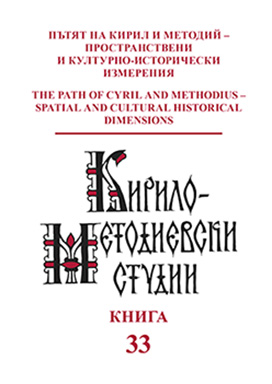Кормчий душам императора Льва Премудрого в старших сборниках предначертаний подвижникам
Kormchii Dusham by Emperor Leo the Wise in the Earlier Collections of the Prescriptions for Ascetics
Author(s): Dmitrii M. BulaninSubject(s): Language studies, Language and Literature Studies
Published by: Кирило-Методиевски научен център при Българска академия на науките
Keywords: Bulgarian literature; word-after-word translation doctrine; bilingualism; ascetic; collection; aphorism; haplography; hyparchetype; compilation; contamination.
Summary/Abstract: Kormchii dusham is named the translation of the prescriptions for monks, which was compiled by Emperor Leo VI the Wise as a series of aphorisms and the interpretations to every one of them (Οἰακιστικὴ ψυχῶν ὑποτύπωσις). The translation is preserved in several East Slavic copies of the 14–17th centuries. The author’s name is omitted in the translation, as it is omitted in some Greek copies of the work. The translation represents a typical specimen of the most ancient period in the history of Slavic literature. A number of peculiar traits indicates that “Kormchii” can be counted among the writings of the 10th century, the “golden age” of Bulgarian literature. Most likely, the translation was made by somebody from the circle of Tsar Symeon. A comparative analysis of the copies brings to the conclusion that at an early stage of its development the translation gave birth to two hyparchetypes (G1, with an error, and G2, with an error corrected), they are preserved in the collections of two types. Each type includes its own selection of the texts, and each type belongs to one out of the two generations. G2, although it arose on the basis of G1, was preserved in the collections of the senior generation.“Kormchii” is placed there at the beginning of the set of contemporary translations similar to the “Kormchii” in their content and in their form. All of them are addressed to monks, and the appropriate teachings are shaped either in the compositions made of the short chapters, or in the series of excerpts taken from the lengthy Byzantine church writings (the “Menaia Izbornik”). The second type of collections belongs to the next generation, and it includes a number of new translations. “Kormchii” was included there from G1, and it is also placed at the beginning of the new formed book. The new translations are similar in genre and in structure to those that composed the “Menaia Izbornik”. Although the localization of the younger type of collections is not easy, it is most likely, that the progenitor of this book formed up as well within the Bulgarian literature of the “golden age”. The second type is interesting in that the compilers of the book sought to pass it off as the opus by Maximus the Confessor. Maximus is acknowledged here as the author of “Kormchii”. The copy of “Kormchii” in the West Russian manuscript Mazurin,No. 616 is very important. The copy contains the readings of the translation before its text was divided into G1 and G2. In addition, the manuscript demonstrates how the title of“Kormchii dusham” gradually expanded its function. Already in the older and younger types of collections, the title was applied not only to the work of Leo the Wise, but also to the book as a whole. In Mazurin codex, it is used as a standard designation of any book with short commandments for monks, and for all pious Christians. The mutual influence of the descendants of G1 and G2 does not allow to follow the text evolution of “Kormchii” step by step. Nevertheless, the existing copies of the translation provide a reliable basis for the reconstruction of this little-known monument of Bulgarian literature.
Journal: Кирило-Методиевски студии
- Issue Year: 2023
- Issue No: 33
- Page Range: 207-245
- Page Count: 39
- Language: Russian
- Content File-PDF

